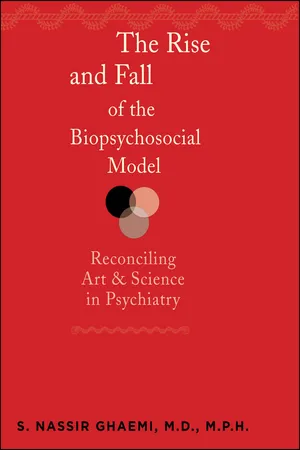
The Rise and Fall of the Biopsychosocial Model
Reconciling Art and Science in Psychiatry
- English
- ePUB (mobile friendly)
- Available on iOS & Android
The Rise and Fall of the Biopsychosocial Model
Reconciling Art and Science in Psychiatry
About this book
2010 Outstanding Academic Title, Choice Magazine
This is the first book-length historical critique of psychiatry's mainstream ideology, the biopsychosocial (BPS) model.
Developed in the twentieth century as an outgrowth of psychosomatic medicine, the biopsychosocial model is seen as an antidote to the constraints of the medical model of psychiatry. Nassir Ghaemi details the origins and evolution of the BPS model and explains how, where, and why it fails to live up to its promises. He analyzes the works of its founders, George Engel and Roy Grinker Sr., traces its rise in acceptance, and discusses its relation to the thought of William Osler and Karl Jaspers.
In assessing the biopsychosocial model, Ghaemi provides a philosophically grounded evaluation of the concept of mental illness and the relation between evidence-based medicine and psychiatry. He argues that psychiatry's conceptual core is eclecticism, which in the face of too much freedom paradoxically leads many of its adherents to enact their own dogmas. Throughout, he makes the case for a new paradigm of medical humanism and method-based psychiatry that is consistent with modern science while incorporating humanistic aspects of the art of medicine.
Ghaemi shows how the historical role of the BPS model as a reaction to biomedical reductionism is coming to an end and urges colleagues in the field to embrace other, less-eclectic perspectives.
Frequently asked questions
- Essential is ideal for learners and professionals who enjoy exploring a wide range of subjects. Access the Essential Library with 800,000+ trusted titles and best-sellers across business, personal growth, and the humanities. Includes unlimited reading time and Standard Read Aloud voice.
- Complete: Perfect for advanced learners and researchers needing full, unrestricted access. Unlock 1.4M+ books across hundreds of subjects, including academic and specialized titles. The Complete Plan also includes advanced features like Premium Read Aloud and Research Assistant.
Please note we cannot support devices running on iOS 13 and Android 7 or earlier. Learn more about using the app.
Information
Table of contents
- Cover Page
- Title Page
- Copyright Page
- Dedication
- Contents
- Preface
- Acknowledgments
- Part I: The Rise of the Biopsychosocial Model
- Part II: The Fall of the Biopsychosocial Model
- Part III: What Next?
- Afterword: Pre-empting the Straw Man
- Appendix: How Can We Teach It? A Proposal for Education of Psychiatrists
- Notes
- A Brief Glossary of Concepts
- References
- Index